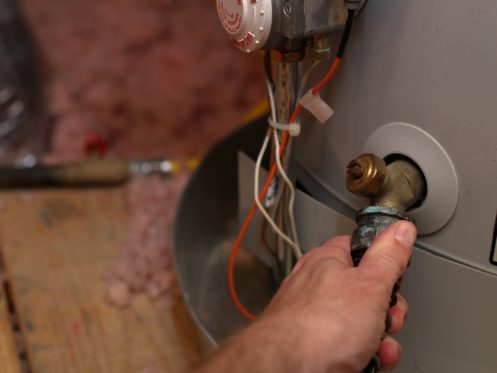Updated May 2025
We all depend on our hot water heaters to take long showers and wash our dishes, but a water heater can begin accumulating sediment from minerals like calcium and magnesium. An older unit might also have problems with rust or oxidation in the lines, and that sediment all settles at the bottom of the tank.
Here are a few of the most common indicators of sediment buildup in your hot water tank:
- Rattling or popping sounds
- Discoloration of the water
- Higher energy bills than usual
- Fluctuating water temperatures
- An insufficient amount of hot water
How much sediment your water heater accumulates and how quickly it builds up will largely depend on how hard your water is, but even new equipment installed in areas with relatively soft water usually experiences this problem sooner or later. It is normally recommended that a water heater be flushed out about every three years. Some homeowners prefer to do this on their own. If you’d like to join them, we’ve laid out the basic steps here. Remember, though, that if you experience any difficulties or run into a problem, you can always count on us at Summit Heating & AC for assistance anywhere in the Greater Denver area.
How to Flush a Water Heater the Right Way
Flushing your water heater is a crucial maintenance task that helps prevent sediment buildup, extend the unit’s lifespan, and restore heating efficiency. If you’re wondering how to flush a water heater at home, the process involves draining the tank, clearing out mineral deposits, and refilling the system—all while ensuring safety precautions are followed. Whether you’re a DIY enthusiast or just exploring your options, learning the right flushing steps can save you from costly repairs down the road.
Shut Off the Water and the Power
The first thing you’ll want to do is turn off the cold water supply valve to the device. You’ll find the knob close to the top of the hot water tank. Turn the knob clockwise to shut off the valve.
You’ll also need to disconnect the power supply. If you have an electric water heater, you can switch off the power at your breaker panel. Leaving the power on without any water in the tank can cause damage to the element and other internal workings. If you have a natural gas water heater, you’ll need to turn the gas valve to the pilot position or to its lowest temperature setting. Use extreme caution at all times when working with gas, and review the procedures for relighting your pilot light safely if it gets blown out.
Drain the Tank
Before you proceed, give the hot water some time to cool down. You don’t want to scald yourself or damage equipment. About two hours should be sufficient.
You can use any household garden hose to drain the tank. Just connect the hose to the drain valve that looks just like any other water spigot. It’s located at the bottom of the water heater. Direct the other end of the hose toward your basement floor drain or outside of the house altogether. If your hot water heater is located in your basement, you might need a pump to direct the water out through a basement window. The water drains out with the force of gravity, and it will not have sufficient pressure to travel any direction besides downward.
You should next open up a hot water tap on the main floor of your house or on any upstairs floor located above your water tank. Now, open the drain valve on the tank and let the water drain out through the garden hose. Depending on the size of your tank, the process can take as few as 20 minutes or as much time as an hour. The drain valve might require some gentle pressure and a little bit of wiggling in order to budge it, but you should never force the valve open or closed. If the valve is being particularly stubborn, you can usually dislodge it by spraying some WD-40 or a comparable lubricant onto the valve and letting it sit for a couple of minutes.
Clear Out the Sediment
After you’ve finished draining the tank, you’ll need to swish around the sediment to make sure it drains out through the hose. The process is similar to swirling around a carafe to clear dried coffee grounds off the bottom, but the tank is way too large to make that an option. Instead, you’ll need to turn the cold water valve on and off several times. The force of the water splashing around should stir up the accumulated sediment enough to help it drain out through the garden hose. If the sediment or scale plugs up the drain valve, that can prevent the water from draining properly. If you encounter this problem, a wet/dry vacuum may be able to dislodge the obstruction. If the issue persists and you can’t clear the blockage, call a plumber.
Repeat this process until the water drains clear from the hose. It will usually take a few attempts. When the water draining from the hose is completely clear, gently close the tank drain valve. Apply even pressure, and don’t force it.
Refill and Restart the Water Heater
The final step is to open up the cold water valve at the top of the device to refill the tank. Turn the knob counterclockwise to fill the tank with water. You’ll know that the tank’s full when you see a steady stream from the hot water tap you left open in one of your sinks. If you have a gas water heater, turn the gas valve knob back on by turning it counterclockwise. If you have an electric water heater in your home, you can turn the power back on at the breaker panel.
Long-Term Water Heater Maintenance
You should routinely monitor your tank for leaks and oxidation. You’ll also want to make sure to check your drain valve for leaks each time you flush your water heater out. If you do see a leak, you can often open and close the drain valve a few times to free up sediment blocking the drain. The extra pressure buildup will be released and the valve should function normally after the blockages are broken up. If the valve continues to leak or if you routinely see standing water in your drain pan, you should turn the cold water supply to the tank off immediately and call a plumber.
If your hot water heater is over 10 years old, there are a lot of benefits to simply buying a new one for your home. Even the best water heaters on the market begin to perform less efficiently near the end, and there are diminishing returns to preserving one that’s approaching the end of its operational life. It’s often a better investment to buy a new water heater or upgrade to a tankless model. New water heaters are more energy efficient than ever, and you can expect to see immediate energy savings.
Professional Plumbing Expertise You Can Count On
If everything you’ve just read sounds like too much bother, there’s always an alternative. Our team at Summit Heating & AC offers plumbing services throughout the Greater Denver area, and we’d be happy to help. Besides water heater maintenance, repair and replacement, you can rely on us for drain cleaning and repair, camera inspections, hydro-jetting, water, sewage or gas line repair or replacement, bathroom plumbing, leak detection and water filtration systems. As our name implies, we also perform heating, cooling and indoor air quality, installation, maintenance and repair. What’s more, our plumbers and technicians have been serving this region since 1998. If you require any of our services or just some friendly advice, call us today.


